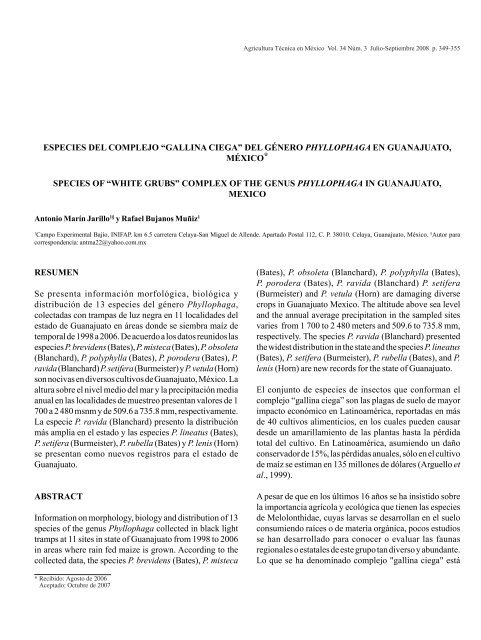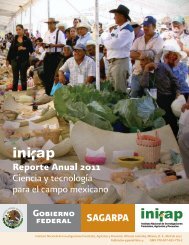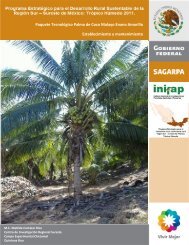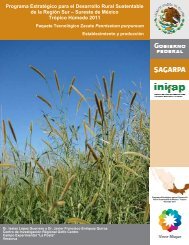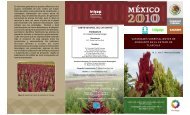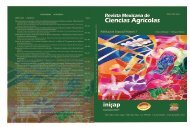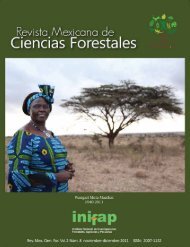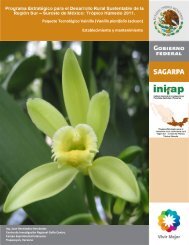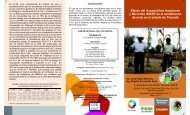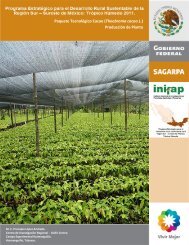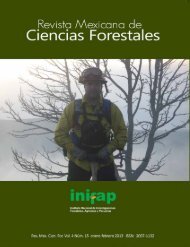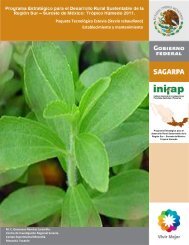Vol. 34 Núm. 3 - Instituto Nacional de Investigaciones Forestales ...
Vol. 34 Núm. 3 - Instituto Nacional de Investigaciones Forestales ...
Vol. 34 Núm. 3 - Instituto Nacional de Investigaciones Forestales ...
Create successful ePaper yourself
Turn your PDF publications into a flip-book with our unique Google optimized e-Paper software.
Agricultura Técnica en México <strong>Vol</strong>. <strong>34</strong> Núm. 3 Julio-Septiembre 2008 p. <strong>34</strong>9-355ESPECIES DEL COMPLEJO “GALLINA CIEGA” DEL GÉNERO PHYLLOPHAGA EN GUANAJUATO,MÉXICO *SPECIES OF “WHITE GRUBS” COMPLEX OF THE GENUS PHYLLOPHAGA IN GUANAJUATO,MEXICOAntonio Marín Jarillo 1§ y Rafael Bujanos Muñiz 11Campo Experimental Bajío, INIFAP. km 6.5 carretera Celaya-San Miguel <strong>de</strong> Allen<strong>de</strong>. Apartado Postal 112, C. P. 38010. Celaya, Guanajuato, México. § Autor paracorrespon<strong>de</strong>ncia: antma22@yahoo.com.mxRESUMENSe presenta información morfológica, biológica ydistribución <strong>de</strong> 13 especies <strong>de</strong>l género Phyllophaga,colectadas con trampas <strong>de</strong> luz negra en 11 localida<strong>de</strong>s <strong>de</strong>lestado <strong>de</strong> Guanajuato en áreas don<strong>de</strong> se siembra maíz <strong>de</strong>temporal <strong>de</strong> 1998 a 2006. De acuerdo a los datos reunidos lasespecies P. brevi<strong>de</strong>ns (Bates), P. misteca (Bates), P. obsoleta(Blanchard), P. polyphylla (Bates), P. poro<strong>de</strong>ra (Bates), P.ravida (Blanchard) P. setifera (Burmeister) y P. vetula (Horn)son nocivas en diversos cultivos <strong>de</strong> Guanajuato, México. Laaltura sobre el nivel medio <strong>de</strong>l mar y la precipitación mediaanual en las localida<strong>de</strong>s <strong>de</strong> muestreo presentan valores <strong>de</strong> 1700 a 2 480 msnm y <strong>de</strong> 509.6 a 735.8 mm, respectivamente.La especie P. ravida (Blanchard) presento la distribuciónmás amplia en el estado y las especies P. lineatus (Bates),P. setifera (Burmeister), P. rubella (Bates) y P. lenis (Horn)se presentan como nuevos registros para el estado <strong>de</strong>Guanajuato.ABSTRACTInformation on morphology, biology and distribution of 13species of the genus Phyllophaga collected in black lighttramps at 11 sites in state of Guanajuato from 1998 to 2006in areas where rain fed maize is grown. According to thecollected data, the species P. brevi<strong>de</strong>ns (Bates), P. misteca(Bates), P. obsoleta (Blanchard), P. polyphylla (Bates),P. poro<strong>de</strong>ra (Bates), P. ravida (Blanchard) P. setifera(Burmeister) and P. vetula (Horn) are damaging diversecrops in Guanajuato Mexico. The altitu<strong>de</strong> above sea leveland the annual average precipitation in the sampled sitesvaries from 1 700 to 2 480 meters and 509.6 to 735.8 mm,respectively. The species P. ravida (Blanchard) presentedthe wi<strong>de</strong>st distribution in the state and the species P. lineatus(Bates), P. setifera (Burmeister), P. rubella (Bates), and P.lenis (Horn) are new records for the state of Guanajuato.El conjunto <strong>de</strong> especies <strong>de</strong> insectos que conforman elcomplejo “gallina ciega” son las plagas <strong>de</strong> suelo <strong>de</strong> mayorimpacto económico en Latinoamérica, reportadas en más<strong>de</strong> 40 cultivos alimenticios, en los cuales pue<strong>de</strong>n causar<strong>de</strong>s<strong>de</strong> un amarillamiento <strong>de</strong> las plantas hasta la pérdidatotal <strong>de</strong>l cultivo. En Latinoamérica, asumiendo un dañoconservador <strong>de</strong> 15%, las pérdidas anuales, sólo en el cultivo<strong>de</strong> maíz se estiman en 135 millones <strong>de</strong> dólares (Arguello etal., 1999).A pesar <strong>de</strong> que en los últimos 16 años se ha insistido sobrela importancia agrícola y ecológica que tienen las especies<strong>de</strong> Melolonthidae, cuyas larvas se <strong>de</strong>sarrollan en el sueloconsumiendo raíces o <strong>de</strong> materia orgánica, pocos estudiosse han <strong>de</strong>sarrollado para conocer o evaluar las faunasregionales o estatales <strong>de</strong> este grupo tan diverso y abundante.Lo que se ha <strong>de</strong>nominado complejo "gallina ciega" está* Recibido: Agosto <strong>de</strong> 2006Aceptado: Octubre <strong>de</strong> 2007


